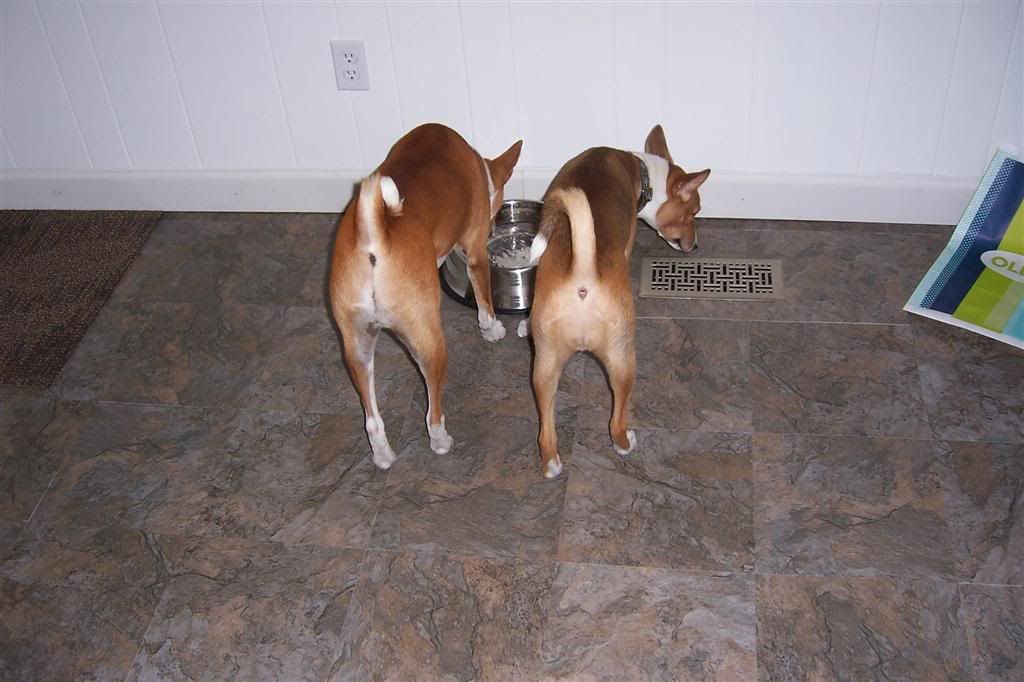New Africans at Basenji Park
-
In a word….yes! It is called genetic diversity :) All of the dogs that we call "domestic" meaning bred down from dogs imported in the '40s, came from 12 dogs...sot that just isn't enough for a really long term healthy gene pool. In the late '80s more were brought in, and within the last few years, we have added some more (but those haven't been included in the AKC stud book...yet!)
Again, I totally agree, however that said… there have been some people that have brought back IMO, "so called" Basenjis that are no more then what I would call village dogs, NOT Basenjis... and should not be included into the AKC stud books when/if they are reopened.
-
Again, I totally agree, however that said… there have been some people that have brought back IMO, "so called" Basenjis that are no more then what I would call village dogs, NOT Basenjis... and should not be included into the AKC stud books when/if they are reopened.
Who makes the decision for which imports are included in the AKC stud books?
-
The Basenji Club of America and each dog is evaluated on its own merit. Right now there is a committee that is reviewing the standards and offering ideas, suggestions, etc on what would be acceptable to include a new import. lvoss is on that committee and she might be able to share some of the committee's ideas.
-
I ditto what everyone else said. Those pups are just beautiful.
Pat
-
I beliveve there was 1 tri and 3 r/w (with the cutest dark muzzles IMO :) )that were brought back along with these two. Tanda is keeping one and Jon is keeping another. The other woman who accompanied them is keeping one & the final pup is going to Colorado.
From the great stories & pics we saw from Tanda (hoping she sends us the pics!) there weren't too many brindles this time & some really nice b/w. But they were not able to bring any b/w this time b/c they were too old.
Andrea is absolutely right broadening the gene pool to breed healthy lineages is the purpose for all of these super expensive trips. We also heard stories that the place where these dogs were found are secluded areas of the jungle in Congo and so the breed has remained fairly intact & pure sort of speak.
However the country is now opening its doors to larger charitable organizations and certain commerce to explore the area's natural resources. Unfortunately the result of this is that the purity of the breed that they've found here will soon become scarce. As the area becomes more accessible to the rest of the world it also becomes accessible to other dogs :( They already saw an example of this in Congo's 2nd largest town where someone brought a German Shepard to the area (un-neutered) and you could already see mixed dogs roaming the area. It's quite sad.
-
For those who are BCOA members look for a detailed explanation of the process in the next issue of the BCOA Bulletin. For those who are not members but are interested in the process and who may want to become members of BCOA and preserving the breed here is a short synopsis of what is going on.
The Native Stock Committee was formed to look into the logistics of opening the AKC Stud Books to incorporate new imports from Africa. The first step was to send an letter to AKC to see if they would be receptive to a petition by the membership. It is important that everyone be aware that it is only with a vote of the BCOA membership that the stud books can be opened. AKC responded that they would consider opening the stud books for native basenjis if the membership voted to do so but would want the club to collect some specific data from experts in the field of genetics, canine health, and conservation to support the inclusion of new stock as well as collecting information from the membership about their attitudes both for and against including new stock. For most of this year the committee has been collecting the required information for AKC as well as constructing a timeline of events as well as criteria for acceptance which will all be published in the next Bulletin. These have been developed using the information that we have collected from the membership and experts in the fields mentioned. The final draft is not quite complete so I all I can say is that we all feel very strongly about preserving a healthy genepool while maintaining basenji type.
There will soon be a website available for the public to look at all the dogs imported from Africa provided the importers have submitted information to the webmaster for inclusion. It is our hope that the process is transparent and that the entire basenji community feels they can follow the process as it unfolds.
-
I've never seen a tri like this one. I want one just like it. Both Basenjis are just breathtaking. The story described by jys1011 is heartbreaking. I wonder why the tails aren't very curled….:confused:
Because "natural" basenjis have less curly tails :) Western breeders have made that tail nice and curly over years of selective breeding. The breed standard calls for one curl up over the back…but lots of very "showy" basenjis have two or three curls. That is cute, but it doesn't make a Basenji more "correct".
-
I wonder why the tails aren't very curled….:confused:
I think the curlier tail was a desirable trait for showing, but was useless in Africa. Here are a few pictures of tails that really show a good difference. Leo’s is super curly and Nexa’s just has a slight curl. Nexa is full african (she's on the right in the first picture and on the left in the second)


-
Because "natural" basenjis have less curly tails :) Western breeders have made that tail nice and curly over years of selective breeding. The breed standard calls for one curl up over the back…but lots of very "showy" basenjis have two or three curls. That is cute, but it doesn't make a Basenji more "correct".
Well, I guess that is mostly true about selective breeding. But look at some of the pictures of the early imports (like in the years of the american Basenji books) There were tight curls and loose curls… and some go along bloodlines. Conformation can play a big part in the tail as to were it is set.
The sire of Kristii, who had no new Af blood had a one loop tail....
-
I've never seen a tri like this one. I want one just like it. Both Basenjis are just breathtaking. The story described by jys1011 is heartbreaking. I wonder why the tails aren't very curled….:confused:
Other then the tail, why do you think it looks different then other Tris? Just curious?
-
Well, I guess that is mostly true about selective breeding. But look at some of the pictures of the early imports (like in the years of the american Basenji books) There were tight curls and loose curls… and some go along bloodlines. Conformation can play a big part in the tail as to were it is set.
The sire of Kristii, who had no new Af blood had a one loop tail....
Right, and one of Dr. Jo's Bs has a really curly tail (current af import). So, yes there are some that have very curly tails in the wild; otherwise we wouldn't have those genes to be be able to pull from.
But, in general, Afs have a looser tail curl…wouldn't you say?
I used to think that tail curl was directly related to length of tail. As in Bs with looong tails, had more curl to them, than short tails...but, uh....Ariel has a loooonnng tail, and not too curly :) But she does wag it more than about ten domestic basenjis put together :)
-
Yes, I do agree, the new Afs in general have a looser tail curl… and I would believe that was from "natural selective" breeding in the wild... at least if you are comparing the ones come from the same general area. And yes the pictures of Dr. Jo's Lukuru some of those have "loose and curly" tails...
Not sure about the tail length... Kristii is pretty short... and really, really curly... and she ways that little top knot all the time... ..
-
Other then the tail, why do you think it looks different then other Tris? Just curious?

Because this tri looks seemingly rare. The black and tan appearance on his face - no white … I don't know, but he is striking to me. Of course I love the signature Basenji white socks and tail tip.
Hmm - I didn't know the super curly tail was developed thru breeding practices. Looking at this tri's tail, with the pictures shown, it doesn't look curled at all. Do you know - maybe I missed it, but are these two from the same litter?
-

Because this tri looks seemingly rare. The black and tan appearance on his face - no white … I don't know, but he is striking to me. Of course I love the signature Basenji white socks and tail tip.
Hmm - I didn't know the super curly tail was developed thru breeding practices. Looking at this tri's tail, with the pictures shown, it doesn't look curled at all. Do you know - maybe I missed it, but are these two from the same litter?
I don't think they're from the same litter.
The Tri's tail does curl over at times, about like the red, just not as often. He is a lot shorter dog. -
Because this tri looks seemingly rare. The black and tan appearance on his face - no white … I don't know, but he is striking to me. Of course I love the signature Basenji white socks and tail tip.
Hmm - I didn't know the super curly tail was developed thru breeding practices. Looking at this tri's tail, with the pictures shown, it doesn't look curled at all. Do you know - maybe I missed it, but are these two from the same litter?
I was thinking that cause you don't really see that many of them (Tri's with no white on the face). The lines that my Kobey comes from has produced many "non" white faced Tris, Black & Whites and Red…ggg...
Many things about todays modern purebred dogs have been done with selective breeding. That is what breeders do, they find what they like about a particular dog and that is what they try to preserve in breeding. So if breeder think/thought that the tighter tail was better looking then the loose one, it became more accepted because there were more of them. Same goes for temperament and health... and selective breeding.
